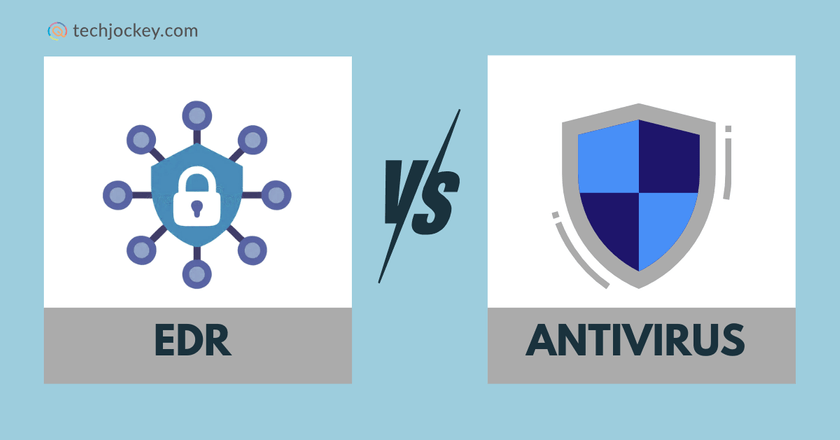EDR vs Antivirus: Key Differences, Strengths, and Why You Need Both for Complete Cybersecurity

Antivirus is the first thing that comes to everyone’s mind whenever there is a talk about protecting computers or business networks. For a very long time, they had been enough to keep most of the computer threats away.
But as of now, cyberattacks are not so normal; they have become more advanced and require more than just an antivirus. With these advanced threats, many new forms of protection have emerged. One of them is Endpoint Detection and Response (EDR).
But what exactly is EDR and Antivirus?
To learn this, let’s break down how each tool works, its strengths and weaknesses, and how they complement each other.
What is Antivirus?
An antivirus software is primarily used to scan your device and block known malicious software, including viruses, worms, trojan horses, and ransomware. Upon spotting suspicious software or a file, an antivirus will block it, delete it, or place it into quarantine, where it cannot be spread further.
Why antivirus software is still useful is that it is simple to implement, relatively cheap (or even free), and effective against popular, widespread malware. On personal devices or small systems, it offers a good starting point for protection. However, antivirus software is not often enough against advanced attacks on businesses.
How Does an Antivirus Work?
Antivirus uses a database of malware signatures. These are unique strings of code that can identify known malicious programs in your system. As you download a file or open up an application, the antivirus scans this database. When it locates a match, it labels the file dangerous and takes action against it.
With time, the threat detection process has been enhanced. Instead of just using signature-based detection, many antivirus software now use heuristic analysis. It’s all about looking for any suspicious behavior patterns, even when the exact code has never been seen before.
Others deploy real-time behavioral tracking where anomalous activity, such as a program that attempts to modify system files or access restricted folders, is detected as harmful.
Even though an antivirus has come a long way, it has definite limits. Being heavily dependent on signatures, it is weak against the new or unidentified threats that have not been included in the database.
Many attackers are likely to invoke polymorphic malware, which changes its code a little every time it spreads. Thus, it bypasses the common signature-based identification of malware.
This is why updating antivirus databases continuously is important. But there is always a lag before new threats are detected, which is one of the key differences between antivirus and EDR.
What is EDR?
Endpoint Detection and Response (EDR) got introduced in 2013 when companies faced more complex cyber threats that were tough for an antivirus to defend.
The concept of EDR is to provide the security team with real-time visibility into what is going on at each endpoint, whether it is a laptop, desktop, or server.
Antivirus is a preventative measure, whereas EDR is about threat detection and response. It also does not wait to match signatures; it proactively monitors processes, network traffic, and system behavior to spot anomalies that may signal an attack in progress.
How Does an EDR Work?
EDR is more than blocking malware. It assists the security teams to look into the origin of an attack, the route it took, and at what level has caused damage. Once a threat is discovered, endpoint detection and response software can:
- Isolate the affected endpoint from the network
- Stop malicious processes
- Roll back harmful changes
- Provide forensic data to prevent future incidents
Automation is one of its largest strengths. Modern attacks are highly dynamic, and EDR has the ability to automatically disconnect an already infected device, kill a suspicious process, or restore safe system files, all without human interaction.
At that, EDR is not plug-and-play. It needs a qualified security team to investigate alerts, update detection rules, and perform investigations. It is also more resource-demanding and more expensive than antivirus software.
However, the cost is worth it in cases where the organization works with sensitive information or is subject to numerous threats.
Suggested Read: What is Endpoint Detection and Response (EDR) and How It Works
EDR vs Antivirus – The Core Differences
| EDR | Antivirus |
|---|---|
| EDR can handle a broader range of threats and protect different endpoints, including servers. | Antivirus is more about defending and mainly focuses on malware prevention. |
| EDR uses machine learning, anomaly detection, and behavioral analysis to catch even unknown threats. | Antivirus looks for known malware through signatures and some heuristic or behavioral checks. |
| It can detect fileless attacks or unusual lateral movement within a network. | It can miss these fileless attacks. |
| It can isolate endpoints, cut off network access, and roll back system changes, all while giving security teams detailed forensic data. | It usually acts in one of three ways when it finds malware: quarantine, delete, or block. |
| It monitors much more – processes, user behavior, system events, and even network traffic. | It is limited to the integrity of files and programs. |
| It requires more expertise. While some responses are automated, many EDR solutions are most effective when skilled analysts. | It is designed to be simple: install it, let it run in the background, and respond when it pops up an alert. |
Antivirus – Strengths and Weaknesses
Pros
- Budget-friendly, often free or low-cost
- Easy to install and requires minimal user effort
- Works well against known malware such as viruses, worms, and Trojans
- Provides a good baseline of protection for personal devices or small setups
Cons
- Relies heavily on signature updates
- Struggles with new or complex threats
- Offers limited visibility into how attacks spread
EDR – Strengths And Weaknesses
Pros
- Provides real-time monitoring and granular visibility
- Detects and responds to emerging or sophisticated threats
- Automates containment, such as isolating devices, killing processes, or rolling back harmful changes
- Supplies forensic data for investigations and the prevention of future incidents
Cons
- Higher cost compared to antivirus
- Requires skilled personnel to interpret alerts and fine-tune systems
- More resource-intensive to set up and manage
Do You Need Both EDR and Antivirus for Complete Security?
In most cases, the answer is yes. Antivirus vs EDR is not an either-or choice; they complement each other.
In the majority of the situations, the answer will be yes. Antivirus and EDR supplement each other; they are not replacements. Antivirus is the initial layer of defense; it blocks everyday threats. EDR is like a safety net and investigative tool, ensuring that anything that escapes the other stages is caught before serious damage is caused.
Just picture an employee clicking on a malicious email attachment. The malware can be detected by antivirus software and deleted instantly. However, even when the malware is new and it is not deleted by an antivirus, EDR will detect it and respond to it.
It may put the device in quarantine, notify employees of security, and reverse changes in time before compromising a system.
This layered defense strategy is crucial for modern cybersecurity. Malware evolves at a pace that is faster than signature-based detection alone, but proactive measures by EDR ensure even zero-day or fileless attacks can be detected and responded to.
EDR or Antivirus: Which Security Tool is Right for You?
Antivirus software can be enough for an individual or a small business. It is affordable, simple to operate, and guards against the most common types of malware.
EDR has, however, become important to organizations, especially mid-sized and large ones. It is risky to rely only on antivirus software for multiple endpoints, sensitive data, and serious attacks.
This does not imply that antivirus is not of use in large organizations. Rather, it must be used in a pair with EDR so as to form a multi-layered security posture. Antivirus stops the most common threats at the door, whereas EDR provides a rich context, depth, and quick response to serious incidents.
So, which one should you choose? We suggest both!
Suggested Read: EDR vs XDR vs MDR: Key Differences Explained for Better Security
Conclusion: Why Combining EDR and Antivirus is the Smart Choice
Cybersecurity is no longer about just keeping out computer viruses. The nature of the threats today is more diverse, advanced, and destructive. An antivirus will still be used, but it will no longer be sufficient as a first line of defense against known malware. EDR steps in and gives real-time monitoring, complex threat detection, and response.
In a discussion between EDR vs antivirus, the smart decision is to choose both. Antivirus is the easy win over everyday common attacks, EDR offers versatility to get through future attacks.
When combined, they form a two-fold defense that is incredibly stronger than each one.
Yashika Aneja is a Senior Content Writer at Techjockey, with over 5 years of experience in content creation and management. From writing about normal everyday affairs to profound fact-based stories on wide-ranging themes, including environment, technology, education, politics, social media, travel, lifestyle so on and so forth, she... Read more




























